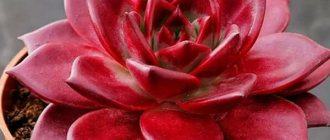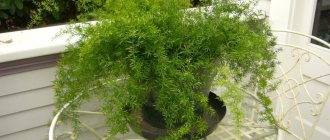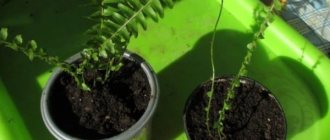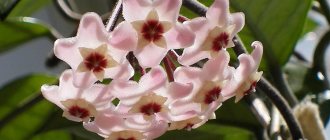After personal computers began to appear in people’s homes, it became fashionable to place cacti near them. Many believe that such a plant has the ability to reduce the level of harmful radiation or completely absorb it. But after some time, most PC users began to notice that for some reason their cacti were withering and dying. The thing is that despite its unpretentiousness and resistance to drought, this plant needs some care.
It should be understood that cacti and deciduous indoor plants need to be cared for differently. If you want a cactus to become a real decoration for your apartment, then before you get one, you need to ask how to properly care for it and what can harm this unusual flower.
The soil
Now in stores there are ready-made soil mixtures for cacti, and even for different types. But you can mix the soil yourself. It should be light, airy, have good drainage and not too sour.
Regular soil for indoor plants must be diluted with raising agents - pebbles, sand, stone chips. Choose a substrate based on lowland peat. To reduce acidity, use dolomite flour and limestone.
Photo: codeseller.ru
Rebutia miniscula (Tiny rebutia)
These cute little cacti are spherical in shape with a diameter of no more than 10 cm. Tiny Rebutia differs from other similar species in the placement of flowers - not at the top of the stem, but at its very base.
Flowers, as a rule, have a pink, orange, red tint, and even the golden color of the spines of the rebutia makes it especially decorative.
This cactus is very favorable to dry air, but requires mandatory spraying in the morning from a spray bottle. Basically, the plant requires the same conditions as other indoor cacti.
Do you have cacti at home? What types are your favorite?
Shading a cactus
If such a need arises, organza or a mosquito net is sufficient for shading. It is imperative to hide freshly transplanted plants from direct sunlight, because they are more sensitive. It is also better to do this in early spring, when the first sunny days arrive. Accustom the cactus to light gradually over the course of a week.
Photo: threadbaresupply.com
How to care for an orchid at home
Fertilizers
Special fertilizers are provided for cacti. During the growing season they are used up to twice a month. In winter, fertilizers are not applied, as the plant must rest. The fertilizer should be used according to the instructions indicated on the package. It is possible to reduce the dosage, but in no case should it be increased. Otherwise, the flower may get sick. If you follow the rules for applying fertilizing, the cactus will delight you with its unusual flowering. The plant requires organic and mineral fertilizers, which should be alternated. Just like earthen soil, they should have low acidity.
Mineral fertilizers are most absorbed by liquid ones. For this reason, they are first diluted with heated rain or boiled water. Feeding should be done during the day or evening. And after a day the flower should be sprayed with water.
Is it possible to place a cactus in a room without a window?
Often, cacti are placed in offices or bathrooms in the hope that their unpretentiousness will help them survive. But in fact, only certain varieties are able to live in such conditions, because most of them are southern desert plants.
At best, the cactus simply will not grow and develop. So we recommend avoiding such decisions. Or at least be sure to study the conditions of keeping a particular species and organize special lighting.
Photo: procvety.net
Varieties
At home, dwarf cacti are often grown; they were born with the help of breeders. You can purchase a huge number of miniature varieties, and placing several dozen of them on the windowsill will not be difficult.
The most popular of the domestic desert cacti are: Echinocereus Knippel and crested, Cereus peruvian, Aporocactus whip-shaped, notocactus, prickly pear, Rebutia dwarf, Echinopsis, Echinocactus Gruson, Chamecereus Sylvester, Espola woolly, Astrophytum capricornus, parodies bloodflower and gold yew-needle.
Varieties of forest cacti grown at home do not have external similarities with cacti that are familiar to everyone. In the wild, they prefer to grow under or on trees. At home, epiphyllum, rhipsalidopsis, and zigocactus (Christmas or Decembrist) are most often grown.
How to water a cactus?
Any cacti must be watered only with warm, settled or filtered water. You must not let water get on the plant itself and allow it to stagnate. Moisture-loving varieties are watered more often, but desert varieties are sufficient several times a season. Therefore, there is no universal scheme, but remember: in the case of cacti, underwatering is always better than overwatering. And be sure to reduce the frequency of watering in winter!
Dracaena: home care, propagation and transplantation
Mistakes when growing succulents
The health of your green pets depends on proper care, as well as whether the succulents want to bloom. Listen to simple tips:
- inspect your plants more often;
- immediately isolate sick or infected specimens;
- do not use hard water for irrigation;
- do not flood the soil, follow the watering regime;
- when transplanting, properly prepare and sterilize the soil;
- for prevention, treat pests and diseases once a year;
- do not replant flowering cacti;
- moving it to another place or simply turning the pot can cause the buds to drop;
- with a lack of light and heat, the plant will not bloom.
Caring for flowering cacti
During this period, protect the plant from direct sunlight, ventilate often and avoid weeds. For flowering varieties, proper wintering with a state of dormancy is especially important in order to have time to accumulate strength. You should not turn the pot with different sides to the sun - let it stand in one place. Do not disturb the cactus with buds with fertilizers, rearrangements or transplants.
Photo: vk.com
Bloom
With good care, Gymnocalycium blooms already in the 3rd year. The plant produces buds in the spring and is fragrant almost until November. With the advent of bell-shaped funnel-shaped flowers, the cactus is transformed, becoming original and unsurpassed.
Tropical charm
Flowering begins with the appearance of tubes at the top, covered with smooth scales. A large number of petals are formed there, collected into a bud, the average diameter of which is 5 cm. The length of the petals varies from 3 to 10 cm (depending on the type).
Each flower produces dark green fruits about 3 cm long and 1.5 to 5 cm in diameter. They have a spindle-shaped or oval shape. Inside contains spherical small seeds.
Gymnocalycium bloomed
Transfer
Cacti are replanted in the spring, when they have just gained strength for active growth. In the process, carefully cut off all damaged roots, disinfect the pot and soil, and give the plant a bath with rooting agent according to the instructions.
When planting, a generous drainage layer is needed. The root collar must remain on the surface, because if the trunk gets into the ground, it will begin to rot the very next time you water it. When you need to strengthen an unstable plant, cover it with decorative stones. After transplanting, do not water the plant for 3-5 days, do not place it in direct sun and do not fertilize for 1-2 weeks.
Photo: topask.ru
How to grow an avocado from a seed at home
Echinopsis
This small, spherical Echinopsis resembles a hedgehog curled up into a ball, which is what gave it its name. But during the flowering period, this shy man turns into a true dandy, enchanting with his sophisticated beauty. As the cactus grows, it stretches upward and can sometimes even reach 2 m.
Echinopsis mamilosa retains its rounded shape and pleases with bright pink flowers with multi-layered petals, and Eyrieza impresses with many “babies” and pointed flowers. The handsome baby in this genus of cacti is the golden echinopsis - a prickly ball with large yellow flowers.
We suggest you read: Is it possible to throw away indoor flowers?
Reproduction of cactus by children
Most cacti simply reproduce by babies, which you simply need to carefully pinch off and root in water or directly in the ground. It is better to take already grown children, at least 1.5-2 cm. When rooting in water, it should be warm (25-30 degrees), and not reach the trunk of the plant. The distance between the water level and the bottom of the cactus is 5-7 mm.
Photo: domashniecvety.ru
Rebutia
This miniature but incredibly charming flowering plant has colorful flowers growing from the bottom of the stem, and not at the top, like most of its other thorny relatives.
In the wild, Rebutia is found on rocks in Peru and Argentina. Flowers appear in the second year of life and impress with bright colors: from rich yellow and red to purple and orange. Rebutia blooms for only 2 days in April–June. This is one of the most favorite types of cacti according to the editors.
Diseases
The most common problems with cacti are fungi and rot. Most often they appear due to improper care: excess moisture and low temperatures. Here it is important to remove damaged areas, reduce watering, provide warmth and sun, and use antifungal sprays and solutions.
If the cactus trunk is too soft, the problem is an excess of moisture. When the root system begins to rot, it is very difficult to save the plant. But you can try with an emergency transplant, removing rotten roots and drying.
A slight change in color is a standard reaction to changing conditions, so most often it will go away on its own. Dropping buds or leaves can be a reaction to stress, and the death of young shoots is a sure sign of damage to the roots during transplantation or due to pests.
Photo: stroysoc.ru
Peculiarities
Like any indoor plant, the cactus mix has its own unique characteristics. There are several main points.
- To grow a “set” of plants, you need to select varieties of cacti that get along well with each other. Often Dutch varieties are combined in the mix.
- The rule for maintaining such a mini-greenhouse is also the same size of all its components. Otherwise, taller cacti will shade others, throwing off the balance.
- Each cactus should be placed in a separate container (mostly small pots are used for this). It is advisable that they be made of plastic, which is mainly suitable for young cacti, or clay. The round shape of the vessels is preferable, since it is thanks to it that air circulation in the soil improves. All containers with plants are placed close to each other in several rows, thereby creating a single composition.
- Combining cactus varieties with other types of succulents in the same mix is not advisable. Despite the same size of plants, their climate and care needs can vary greatly, which subsequently complicates the process of growth and development of these representatives of the flora.
- Unlike a simple cactus, mixes look very unusual and creative, since the components harmoniously complement each other and form different compositions. This green decor fits well into some interior concepts, for example, eco-style.
- You can expect plants to bloom only with proper care. For the most part, cacti bloom infrequently and only under ideal conditions.
- The most suitable place to place a small greenhouse would be a window sill, since it receives a lot of the light that cacti need. However, you should ensure that plants are not located too close to heating radiators.
Cactus pests
Pests on cacti are rare. Occasionally, small mites settle on them, leaving behind rusty spots. Less common are whitish scale insects, scale insects and false scale insects. The methods of control are the same: remove everything that can be removed with a cotton swab dipped in alcohol, and treat the plant with an insecticide according to the instructions.
Photo: waysi.ru
Did you like the post? Subscribe to our channel in Yandex.Zen, it really helps us in our development!
Possible problems
Echinocactus immediately reacts to errors in care or maintenance in inappropriate conditions by changing its appearance:
| Problem | Possible Solution |
| The spines lighten and fall off | Lack of sun. The plant needs to find a more illuminated place. |
| Brown spots on the stem | The plant is cold. If you do not immediately move the cactus to a warmer room, it will die. |
| Softening the stem | Rotting of the root system from waterlogging and hypothermia. To save the plant, it needs to be transplanted into a new substrate and watering normalized. |
| Darkening of needles | This phenomenon is not associated with any problems. The needles may change color as the plant ages. |
| Slowing or stopping growth | Occurs when the cactus is at too high a temperature. Move it to a cooler location and growth will resume. |
| Stem deformation | The cactus begins to grow in one direction if it lacks light or heat. To ensure that the stem forms a regular ball, turn the plant from time to time with the other side towards the light source. |
Bibliography:
- Thorn: how to create a green oasis at home. Amazing cacti and succulents / Zhinel Leon. — M.: Eksmo, 2022.— 224 p.: ill.
- Cacti and succulents: Illustrated Encyclopedia / Anderson M. - M.: Niola 21st century, 2002, - 264 pp.: ill.
What substrate is needed
For each type of cactus you need to buy your own soil mixture. Although there are general features that should be followed. They relate to breathability, nutrition, and lightness. In addition, it is important to maintain weak acidity (pH 4.5 – 6).
If you want to prepare the substrate yourself, you can use the following composition:
- river sand and leaf soil (1:1);
- a little peat;
- some charcoal.
Young cacti need more nutrients, so leaf soil is added to the soil mixture in a larger volume.
Shape selection
The main requirement for cactus pots is the presence of drainage holes at the bottom, and the choice of shape and design has more aesthetic than practical significance. For bushy and spreading succulents, simple white, beige, and brown round pots are suitable. Small, rarely flowering plants are planted in bright containers of unusual shapes.
Compositions on window sills can be placed in yellow or orange containers. So even on a cloudy day it will seem like the sun's rays are playing on the window. Plants with strict lines are most suitable for containers that match the Japanese style. For example, flat rectangular containers on a wooden stand, decorated with hieroglyphs, or flowerpots with contrasting colors from light to darker colors.
Pots for cacti and succulents
This type of container is a hanging or tabletop structure in which the main pot with the plant is placed. In the interior it is used for decorative purposes: in terms of the beauty of decoration and painting, some products are not inferior to expensive vases. You can use the following as a flowerpot:
- bird cages;
- glass vessels of different shapes (spherical, multifaceted);
- flowerpots woven from wicker or felt;
- wooden blocks with a hole for a pot;
- hollowed out stumps and snags;
- ceramic figurines with cavities for flowerpots;
- structures made of concrete and gypsum.
Collections of adult cacti in small ceramic flowerpots are placed inside flower pots, and the free space between them is filled with substrate mixed with sand. In this way, plants are protected from waterlogging, but it does not work with plastic flowerpots.
The pots do not have holes for drainage, so for growing succulents directly in the container, it is recommended to add a thicker drainage layer. If this is not done, the roots of the cacti will rot and the plants will quickly die.
Square pots and bowls
It is most convenient to plant cacti of the same type in square and rectangular flowerpots. Collected in one place in the form of collections, they look compact and harmonious.
Specialized stores sell plastic bowls with trays designed for cultivating succulents. Beautiful compositions of plants that are similar in the way they are cared for can be created in ceramic and glass flat vases by lining the bottom of the container with a thick layer of expanded clay.
Pot material - what to choose
Different types of succulents are most often grown in pots made of baked clay or plastic. Expensive ceramic flowerpots look beautiful and traditionally remain in demand, although they are not without drawbacks. They have the following characteristics:
- Porosity. The surface of clay products “breathes”, quickly absorbs and evaporates moisture, but this is not always good: the plant has to be watered more often, which leads to the formation of a salt coating on the inner walls of the pot and rapid alkalization of the soil.
- Heavy weight. Heavy containers are stable, you can safely grow tall types of cacti in them, but they are difficult to move from place to place.
- Ability to maintain shape. Ceramic flowerpots practically do not change in appearance over time and plant roots are unable to destroy them, but if handled carelessly, they simply break.
Plastic pots are either disposable or reusable.
The first ones are very cheap, break easily and are used mainly for pre-sale transplantation of plants grown in greenhouses and greenhouses. Reusable flowerpots are made of dense plastic; they are also light in weight, but relatively durable. They look much more attractive, but they also cost significantly more.
It is not recommended to grow large succulents in them: the low weight of the flowerpots makes them unstable, capable of tipping over even from a slight push. However, their main drawback is that the walls of plastic products do not allow moisture to pass through. To prevent the roots of cacti growing in such pots from rotting, the amount of water for watering them is limited to ⅓ of the volume required by plants living in ceramics.
In addition, the substrate enclosed in plastic dries unevenly - its surface is already completely dry on top, but moisture is still retained in the deeper layers. Flowerpots made from this material are better suited for planting low and medium-sized plants.
A small container contains less soil, so the evaporation of excess liquid occurs more evenly and the watering procedure will not cause damage to the roots of the succulent.











